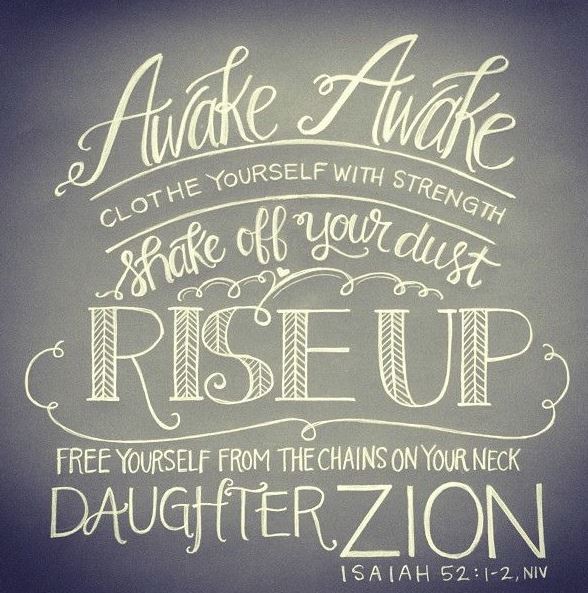 Pistols for sale at Target Masters, an indoor shooting center, in Garland, Texas on March 3.Cooper Neill for The Washington Post via Getty Images
Pistols for sale at Target Masters, an indoor shooting center, in Garland, Texas on March 3.Cooper Neill for The Washington Post via Getty Images
America is an exceptional country when it comes to guns. It’s one of the few countries in which the right to bear arms is constitutionally protected. But America’s relationship with guns is unique in another crucial way: Among developed nations, the US is far and away the most violent — in large part due to the easy access many Americans have to firearms.
These charts and maps show what that violence looks like compared with the rest of the world, why it happens, and why it’s such a tough problem to fix.
1) America has six times as many firearm homicides as Canada, and nearly 16 times as many as Germany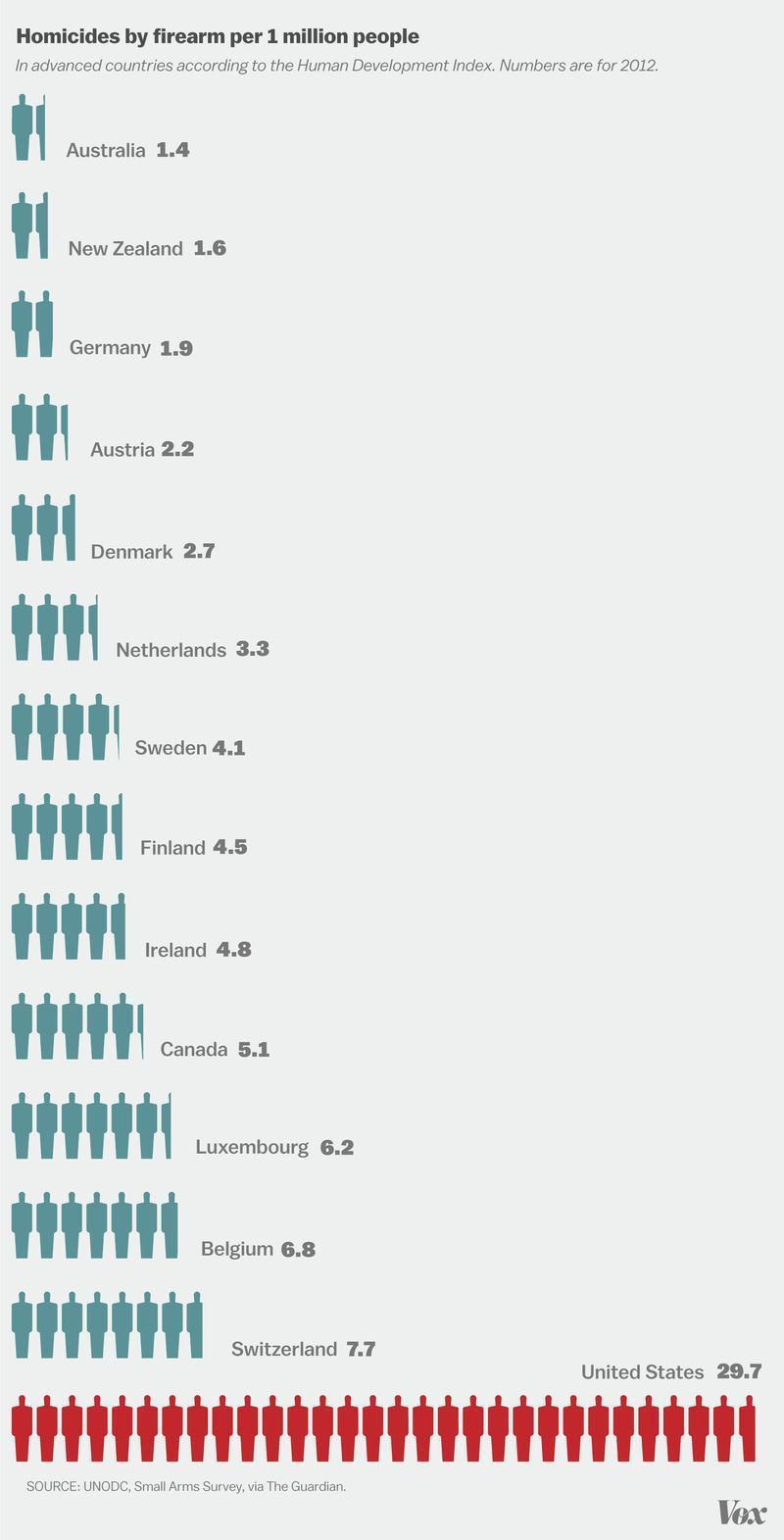 Javier Zarracina/Vox
Javier Zarracina/Vox
This chart, compiled using United Nations data collected by Simon Rogers for the Guardian, shows that America far and away leads other developed countries when it comes to gun-related homicides. Why? Extensive reviews of the research by the Harvard School of Public Health’s Injury Control Research Center suggest the answer is pretty simple: The US is an outlier on gun violence because it has way more guns than other developed nations.
2) America has 4.4 percent of the world’s population, but almost half of the civilian-owned guns around the world Javier Zarracina/Vox
3) There have been more than 1,500 mass shootings since Sandy Hook
Javier Zarracina/Vox
3) There have been more than 1,500 mass shootings since Sandy Hook
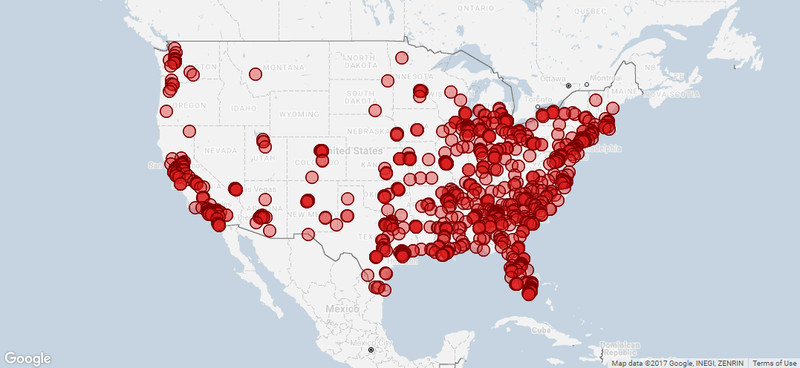 Soo Oh/Vox
Soo Oh/Vox
In December 2012, a gunman walked into Sandy Hook Elementary School in Newtown, Connecticut, and killed 20 children, six adults, and himself. Since then, there have been at least 1,518 mass shootings, with at least 1,715 people killed and 6,089 wounded as of October 2017.
The counts come via the Gun Violence Archive, which has hosted a database that tracks mass shootings since 2013. But since some shootings go unreported, the database is likely missing some, as well as the details of some of the events.
The tracker uses a fairly broad definition of “mass shooting”: It includes not just shootings in which four or more people were murdered, but shootings in which four or more people were shot at all (excluding the shooter).
Even under this broad definition, it’s worth noting that mass shootings make up a tiny portion of America’s firearm deaths, which totaled more than 33,000 in 2014.
4) On average, there is more than one mass shooting for each day in America Christopher Ingraham/Washington Post
Christopher Ingraham/Washington Post
Whenever a mass shooting occurs, supporters of gun rights often argue that it’s inappropriate to bring up political debates about gun control in the aftermath of a tragedy. For example, former Louisiana Gov. Bobby Jindal, a strong supporter of gun rights, criticized former President Barack Obama for “trying to score cheap political points” when Obama mentioned gun control after a mass shooting in Charleston, South Carolina.
But if this argument is followed to its logical end, then it will never be the right time to discuss mass shootings, as Christopher Ingraham pointed out at the Washington Post. Under the broader definition of mass shootings, America has nearly one mass shooting a day. So if lawmakers are forced to wait for a time when there isn’t a mass shooting to talk gun control, they could find themselves waiting for a very long time.
5) States with more guns have more gun deaths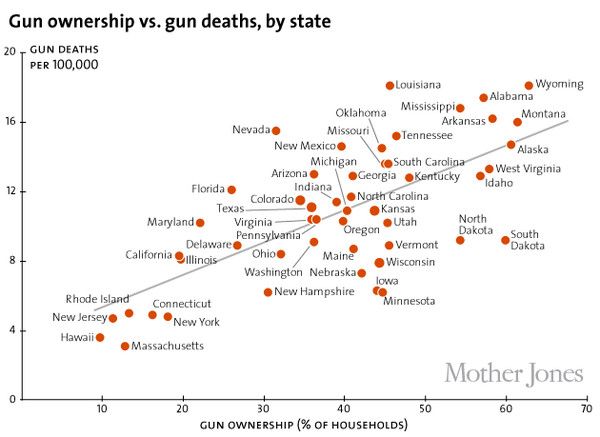 Mother Jones
Mother Jones
Using data from a study in Pediatrics and the Centers for Disease Control and Prevention, Mother Jones put together the chart above that shows states with more guns tend to have far more gun deaths. And it’s not just one study. “Within the United States, a wide array of empirical evidence indicates that more guns in a community leads to more homicide,” David Hemenway, the Harvard Injury Control Research Center’s director, wrote in Private Guns, Public Health.
Read more in Mother Jones’s “10 Pro-Gun Myths, Shot Down.”
6) It’s not just the US: Developed countries with more guns also have more gun deaths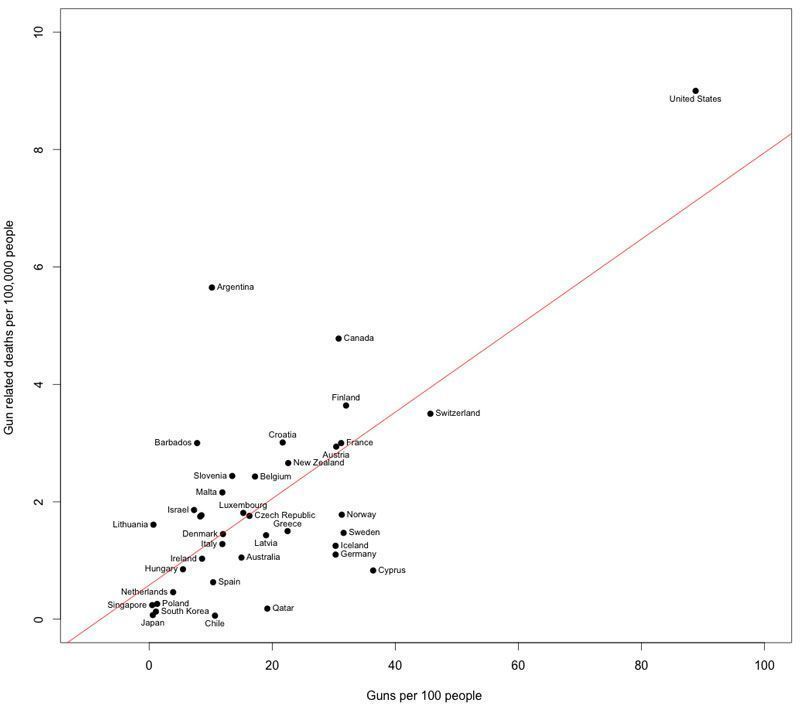 Josh Tewksbury
7) States with tighter gun control laws have fewer gun-related deaths
Josh Tewksbury
7) States with tighter gun control laws have fewer gun-related deaths
 Zara Matheson/Martin Prosperity Institute
Zara Matheson/Martin Prosperity Institute
When economist Richard Florida took a look at gun deaths and other social indicators, he found that higher populations, more stress, more immigrants, and more mental illness didn’t correlate with more gun deaths. But he did find one telling correlation: States with tighter gun control laws have fewer gun-related deaths. (Read more at Florida’s “The Geography of Gun Deaths.”)
This is backed by other research: A 2016 review of 130 studies in 10 countries, published in Epidemiologic Reviews, found that new legal restrictions on owning and purchasing guns tended to be followed by a drop in gun violence — a strong indicator that restricting access to guns can save lives.
8) Still, gun homicides (like all homicides) have declined over the past couple decades
The good news is that all firearm homicides, like all homicides and crime, have declined over the past two decades. (Although that may have changed in 2015 and 2016, with a recent rise in murders nationwide.)
There’s still a lot of debate among criminal justice experts about why this crime drop is occurring — some of the most credible ideas include mass incarceration, more and better policing, and reduced lead exposure from gasoline. But one theory that researchers have widely debunked is the idea that more guns have deterred crime — in fact, the opposite may be true, based on research compiled by the Harvard School of Public Health’s Injury Control Center.
9) Most gun deaths are suicidesAlthough America’s political debate about guns tends to focus on grisly mass shootings and murders, a majority of gun-related deaths in the US are suicides. As Dylan Matthews explained for Vox, this is actually one of the most compelling reasons for reducing access to guns — there is a lot of research that shows greater access to guns dramatically increases the risk of suicide.
10) The states with the most guns report the most suicides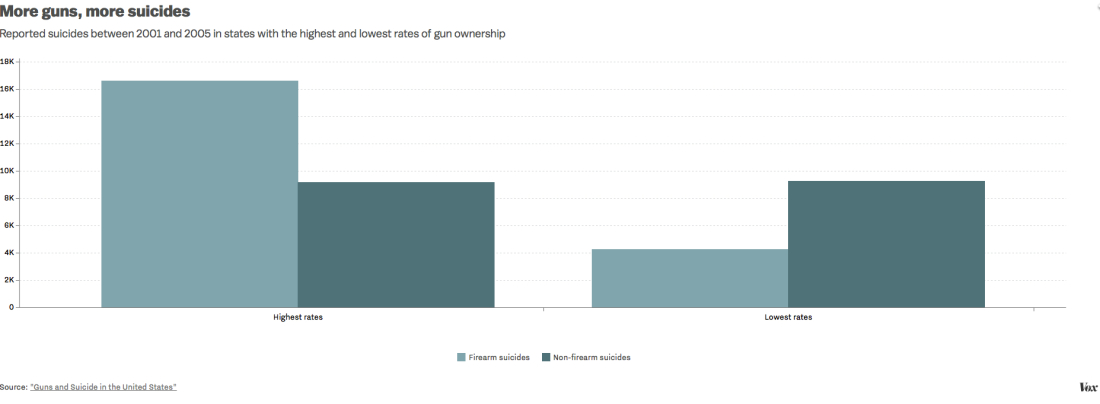 11) Guns allow people to kill themselves much more easily
11) Guns allow people to kill themselves much more easily
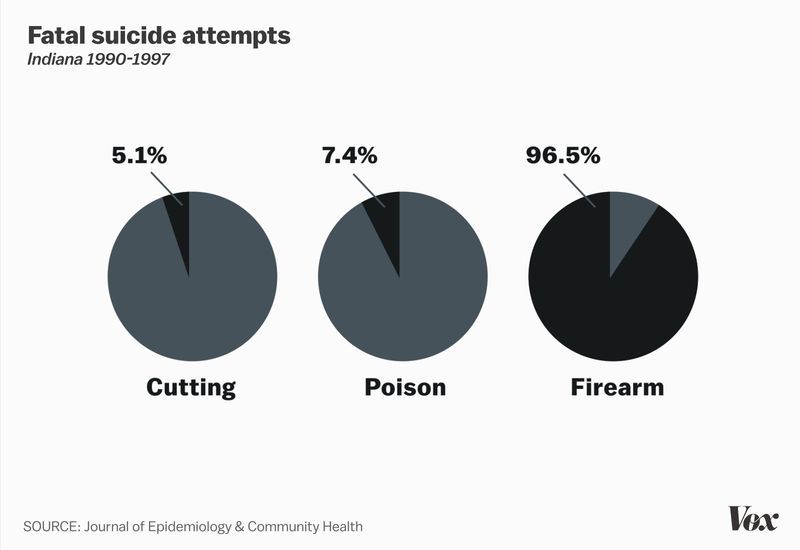 Estelle Caswell/Vox
Estelle Caswell/Vox
Perhaps the reason access to guns so strongly contributes to suicides is that guns are much deadlier than alternatives like cutting and poison.
Jill Harkavy-Friedman, vice president of research for the American Foundation for Suicide Prevention, previously explained that this is why reducing access to guns can be so important to preventing suicides: Just stalling an attempt or making it less likely to result in death makes a huge difference.
“Time is really key to preventing suicide in a suicidal person,” Harkavy-Friedman said. “First, the crisis won’t last, so it will seem less dire and less hopeless with time. Second, it opens the opportunity for someone to help or for the suicidal person to reach out to someone to help. That’s why limiting access to lethal means is so powerful.”
She added, “[I]f we keep the method of suicide away from a person when they consider it, in that moment they will not switch to another method. It doesn’t mean they never will. But in that moment, their thinking is very inflexible and rigid. So it’s not like they say, ‘Oh, this isn’t going to work. I’m going to try something else.’ They generally can’t adjust their thinking, and they don’t switch methods.”
12) Programs that limit access to guns have decreased suicides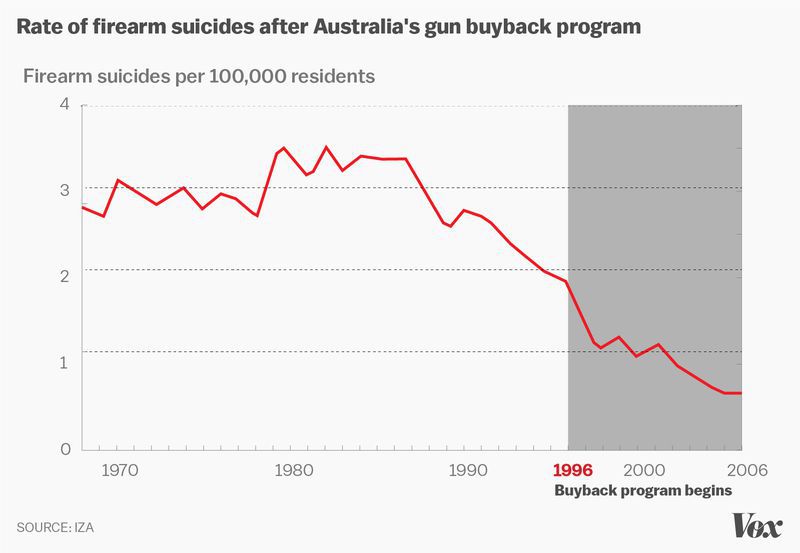 Estelle Caswell/Vox
Estelle Caswell/Vox
When countries reduced access to guns, they saw a drop in the number of firearm suicides. The data above, taken from a study by Australian researchers, shows that suicides dropped dramatically after the Australian government set up a gun buyback program that reduced the number of firearms in the country by about one-fifth.
The Australian study found that buying back 3,500 guns per 100,000 people correlated with up to a 50 percent drop in firearm homicides, and a 74 percent drop in gun suicides. As Dylan Matthews noted for Vox, the drop in homicides wasn’t statistically significant. But the drop in suicides most definitely was — and the results are striking.
Australia is far from alone in these types of results. A study from Israeli researchers found that suicides among Israeli soldiers dropped by 40 percent — particularly on weekends — when the military stopped letting soldiers take their guns home over the weekend.
This data and research have a clear message: States and countries can significantly reduce the number of suicides by restricting access to guns.
13) Since the shooting of Michael Brown, police have killed at least 2,900 people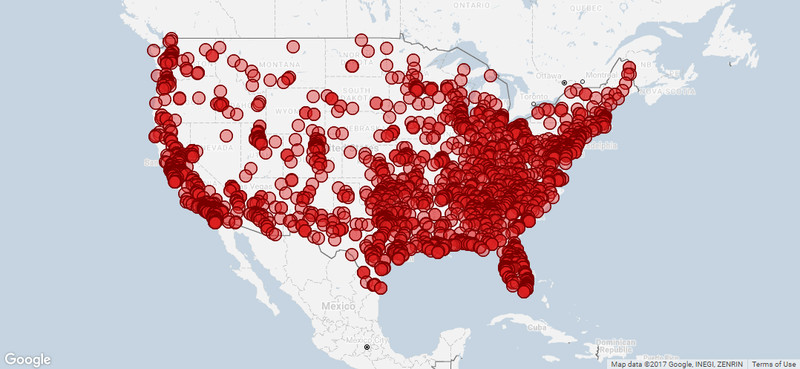 Soo Oh/Vox
Soo Oh/Vox
Since police shooting of Michael Brown in Ferguson, Missouri, on August 9, 2014, police have killed at least 2,902 people as of May 2017.
Fatal Encounters, a nonprofit, has tracked these killings by collecting reports from the media, public, and law enforcement and verifying them through news reports. Some of the data is incomplete, with details about a victim’s race, age, and other factors sometimes missing. It also includes killings that were potentially legally justified, and is likely missing some killings entirely.
A huge majority of the 1,112 deaths on the map are from gunshots, which is hardly surprising given that guns are so deadly compared with other tools used by police. There are also noticeable numbers of fatalities from vehicle crashes, stun guns, and asphyxiations. In some cases, people died from stab wounds, medical emergencies, and what’s called “suicide by cop,” when people kill themselves by baiting a police officer into using deadly force.
14) In states with more guns, more police officers are also killed on duty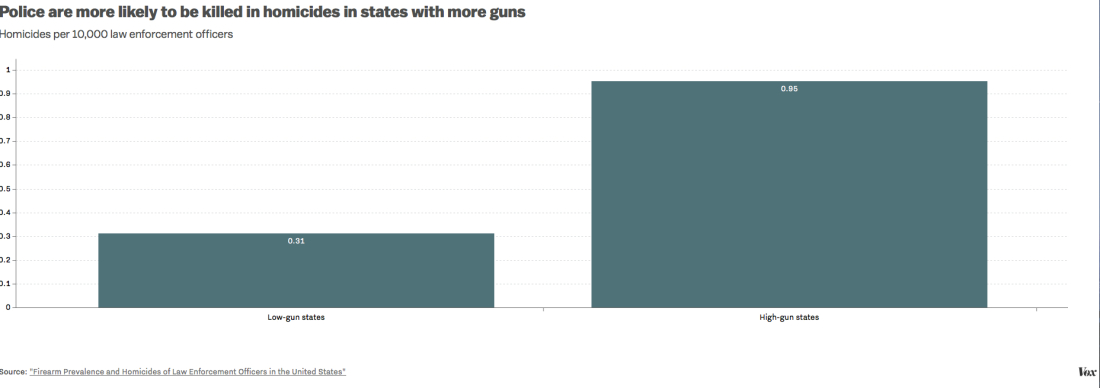
Given that states with more guns tend to have more homicides, it isn’t too surprising that, as a study in the American Journal of Public Health found, states with more guns also have more cops die in the line of duty.
Researchers looked at federal data for firearm ownership and homicides of police officers across the US over 15 years. They found that states with more gun ownership had more cops killed in homicides: Every 10 percent increase in firearm ownership correlated with 10 additional officers killed in homicides over the 15-year study period.
The findings could help explain why US police officers appear to kill more people than cops in other developed countries. For US police officers, the higher rates of guns and gun violence — even against them — in America mean they not only will encounter more guns and violence, but they can expect to encounter more guns and deadly violence, making them more likely to anticipate and perceive a threat and use deadly force as a result.
15) Support for gun ownership has sharply increased since the early ’90s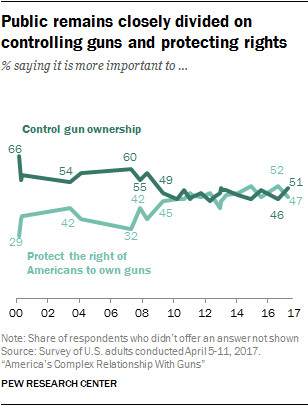
Over the past 20 years, Americans have clearly shifted from supporting gun control measures to greater support of “protecting the right of Americans to own guns,” according to Pew Research Center surveys. This shift has happened even as major mass shootings, such as the attacks on Columbine High School and Sandy Hook Elementary School, have received more press attention.
16) High-profile shootings don’t appear to lead to more support for gun control
Although mass shootings are often viewed as some of the worst acts of gun violence, they seem to have little effect on public opinion about gun rights, based on surveysfrom the Pew Research Center. That helps explain why Americans’ support for the right to own guns appears to be rising over the past 20 years even as more of these mass shootings make it to the news.
17) But specific gun control policies are fairly popular
Although Americans say they want to protect the right to bear arms, they’re very much supportive of many gun policy proposals — including some fairly contentious ideas, such as more background checks on private and gun show sales and banning semi-automatic and assault-style weapons, according to Pew Research Center surveys.
This type of contradiction isn’t exclusive to gun policy issues. For example, although most Americans in the past said they don’t like Obamacare, most of them also said they like the specific policies in the health-care law. Americans just don’t like some policy ideas until you get specific.
For people who believe the empirical evidence that more guns mean more violence, this contradiction is the source of a lot of frustration. Americans by and large support policies that reduce access to guns. But once these policies are proposed, they’re broadly spun by politicians and pundits into attempts to “take away your guns.” So nothing gets done, and preventable deaths keep occurring.

by German [email protected]@vox.com
Nov 5, 2017 -30- NOT NORMAL not normal…Bang…………….bang bang….NOT Normal NOT NormalNOT NormalNOT NormalNOT NormalNOT NormalNOT NORMAL…………….bang bang bang….NOT Normal NOT NormalNOT NormalNOT NormalNOT NormalNOT NormalNOT NORMAL…………….bang bang bang bang….NOT Normal NOT NormalNOT NormalNOT NormalNOT NormalNOT Normal NOT NOT NOT….. w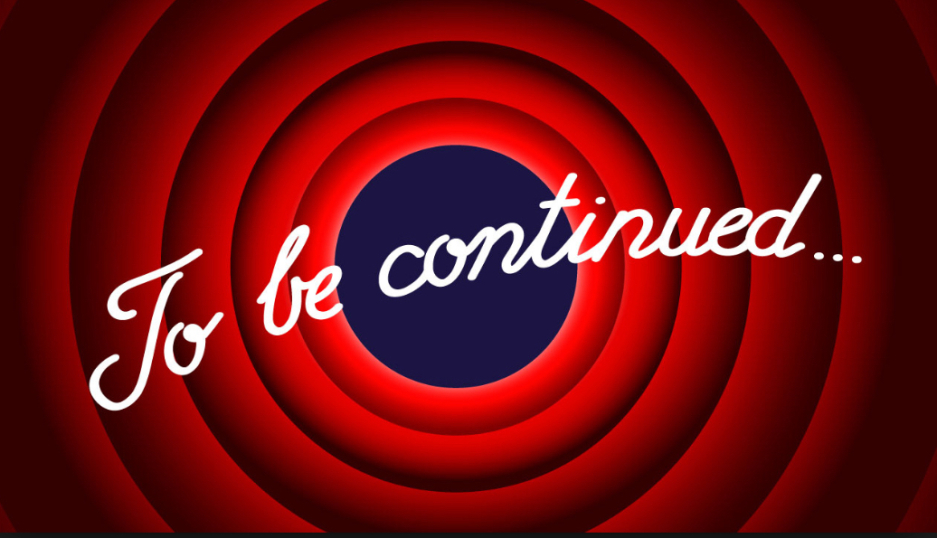
 Aggravated Aggregator Chews The News
Aggravated Aggregator Chews The News
SHARE
- More





